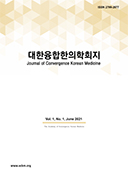고지방식이를 급여한 마우스의 간과 HepG2 세포에서 TJGB의 효과에 대한 연구
Effect of TJGB on the liver of high-fat diet-fed mice and the viability of HepG2 cells
박예진 (상지대학교 한의과대학 한방재활의학과)
안효진 (경희대학교 약학대학 천연물융합신약개발학과)
Abstract
Objectives: This study was performed to investigate the effect of TJGB on the liver of high-fat diet (HFD)-fed mice and the cell viability of HepG2 cells. Methods: After a week adaptation, 8-week-old C57BL/6N mice were fed with a 45% HFD or normal diet for 3 weeks. For the next 9 weeks, the mice were divided into 6 groups: normal diet group; HFD group; HFD plus orlistat group; HFD plus Ephedra sinica Stapf (ES) group; HFD plus low dose of TJGB group; HFD plus high dose of TJGB group. To estimate the effect of TJGB in the liver of HFD-fed mice, the protein expressions of phospho-acetyl-CoA carboxylase (p-ACC) and liver X Receptor (LXR) were determined by Western blot assay. The cell viability of ES and TJG was also evaluated in HepG2 cells. Results: The administration of TJGB had little effect on the protein expressions of p-ACC and LXR in the liver of HFD-fed mice. And the cytotoxicity was showed above 7.8 ㎍/mL in HepG2 cells. Conclusion: Further research is needed to evaluate the mechanism of TJGB on hepatic steatosis and cytotoxicity in HepG2 cells.
- keywords
- High-fat diet, HepG2 cells, Obesity, Liver, TJGB
- 다운로드 수
- 조회수
- 0KCI 피인용수
- 0WOS 피인용수

